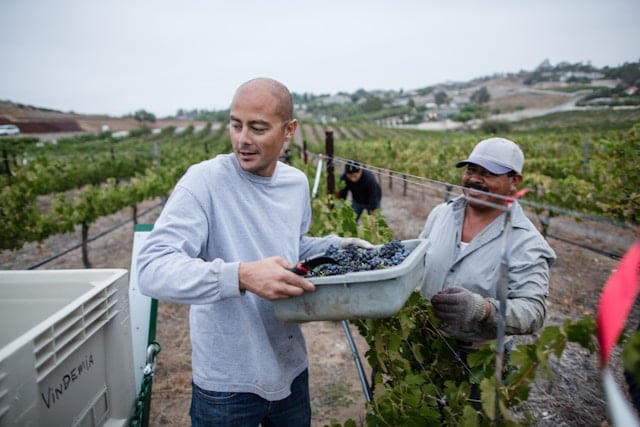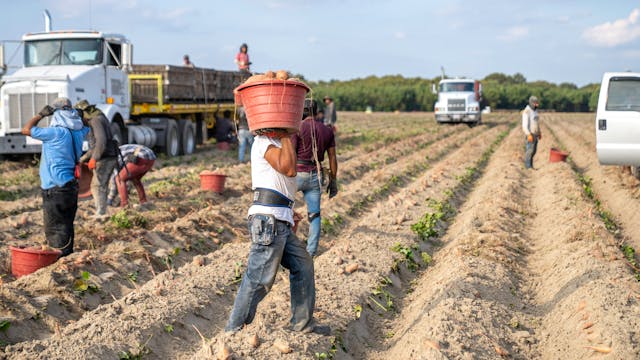How Farmers Can Attract and Retain Talent in a Changing Industry
It’s harvest. You’re short two people again. The ones who said they’d start last week never showed up, and the work’s piling up. So how do you find farm workers to hire?
The labor shortage is real, and it’s not getting easier. Young people are going into other fields, experienced workers are retiring, and when someone does show interest, they’re weighing your farm against jobs with air conditioning and weekends off.
But some farms are actually hiring, and keeping good people. Here’s what they’re doing differently.

Compete on More Than Just the Hourly Rate
Figure out what other farms and local employers are paying. If you can’t match the top rates, think about what else you can offer:
- Performance bonuses tied to harvest or efficiency
- Profit-sharing for people who stick around
- Clear raises as people learn more skills
- Housing or help with housing costs (this matters more than you’d think)
Most importantly, be straight about pay in your job posts. “Competitive wages” means nothing and wastes everyone’s time. “$16-20/hour depending on experience, plus housing” gets you applicants who know what they’re getting into.
Create Actual Career Pathways
A lot of people leave ag because they don’t see anywhere to go, not because they don’t like the work. If someone’s doing the same job five years in with no change, they’ll probably move on unless that’s exactly what they want.
Think about what progression looks like on your place:
- Equipment operator → equipment manager → operations supervisor
- Field worker → crew lead → production manager
- General labor → specialized work (irrigation, IPM, livestock handling)
Write down what skills each level needs. When someone knows that learning to run the combine or getting their CDL means more responsibility and better pay, they’ve got a reason to stick around and build skills.
Bring this up when you’re hiring too. It helps people see a future with you.
Invest in Training
Quality training does three things: it makes workers more productive, reduces costly mistakes, and shows you’re invested in their success. That third point matters more than most people realize.
Practical approaches:
- Partner with local agricultural extension offices for formal training sessions
- Send promising employees to workshops on precision agriculture, sustainable practices, or equipment certification
- Create simple written procedures for complex tasks (irrigation scheduling, livestock protocols, equipment maintenance checklists)
- Designate your best workers as mentors and compensate them for that additional responsibility
When you pay for someone’s pesticide applicator license or have someone mentor them, you’re not just building their skills. You’re showing them they have a future worth investing in.
Modernize the Work Where It Makes Sense
You don’t need autonomous tractors or a complete tech overhaul. But if you are still using paper or spreadsheets to manage harvest tracking, you might be making things harder than they need to be.
Basic tech that helps:
- Group text (WhatsApp, GroupMe, whatever) for crew communication
- Simple farm management software for tracking tasks and hours. Something like Farmable keeps things organized without being complicated.
- Equipment with features that reduce physical wear and tear
This isn’t about keeping up with trends. It’s about making the work less of a headache. When your irrigation system sends a phone alert instead of requiring someone to drive out and check it, they can stay on top of things while getting other work done.

Offer Flexibility Where Possible
Ag work is seasonal, that’s just how it is. But expecting 70-hour weeks year-round, even during slow periods, is a good way to lose people to farms that adjust hours based on what’s actually happening.
Some things to consider:
- Four 10-hour days during slower times instead of five 8-hour days
- Consistent days off when things calm down (like weekends in winter)
- Post the schedule ahead of time during busy season so people can plan around it
- Give people time off for important stuff when you can
Harvest shares during peak season let employees take home produce. Doesn’t cost you payroll, but it matters to people feeding their families.
Hire for Attitude, Train for Skill
The person with farming experience who shows up late, complains constantly, and disrupts the crew will cost you more than the enthusiastic beginner who asks questions and shows up ready to work.
Look for:
- Reliability (did they show up on time for the interview?)
- Problem-solving orientation (how do they describe handling past challenges?)
- Physical realism (do they understand the work is actually hard?)
- Willingness to learn (do they ask questions about the operation?)
Some of the best hires come from unexpected places. Former military personnel often excel at agricultural work. Career changers seeking purpose over paychecks can become your most dedicated employees.

Make Hiring Easier on Yourself
Finding people starts with making yourself findable. A Facebook post shared to your personal network has limited reach. A proper job posting on specialized platforms reaches hundreds or thousands of qualified candidates actively looking for farm work.
FarmingWork.com connects farmers with agricultural workers specifically looking for farm jobs—not people browsing general employment sites who might consider farming. The platform is built for agricultural hiring, meaning you’re reaching people who understand what they’re signing up for.
Beyond specialized job boards, don’t overlook:
- Local agricultural high schools and community college programs
- Cooperative extension networks
- Farm Bureau connections
- Word of mouth from your best employees (consider referral bonuses)
Retain Through Real Communication
Most people don’t quit because the work’s too hard—they quit because they feel ignored or disrespected.
Talk to your crew regularly. Doesn’t need to be formal. A quick conversation while you’re both checking equipment or between jobs works fine. Ask them:
- “What’s going well?”
- “What’s making your job harder than it should be?”
- “What would help you out the most?”
Listen to what they tell you. You won’t be able to act on everything, but explain your thinking when you can’t. “Can’t swing that equipment this year, but we’ll look at it next budget cycle” is better than ignoring them.
When someone quits, talk to them about why.
Start with what works for your operation
You don’t need to do everything at once. Pick a few things that make sense for your operation.
Maybe you start by getting your pay right and setting up a group text for the crew. Or maybe you write down your training process, try some ag-specific job boards, and check in with people every few months.
The farms hiring successfully right now aren’t always the biggest or the ones paying the most. They’re the ones who’ve figured out that good people need more than just a paycheck. They need to know what’s expected, have someone to talk to when things go sideways, and feel like they matter.
The labor shortage is real, but you can work with it. Good workers are out there. The question is whether they can find your operation, and whether they’ll stick around once they do.

